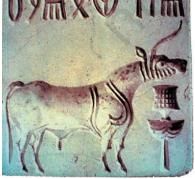Test: The First Cities and the Vedic Age - 2 - Class 6 MCQ
10 Questions MCQ Test - Test: The First Cities and the Vedic Age - 2
Identify the incorrect statement about Harappan faience:
The ________ in Mohenjodaro was made water-tight with a layer of natural tar, and water was probably brought in from a well.
Archaeologists found a set of unique objects in Harappan cities, including red pottery painted with designs in black, stone weights, seals, special beads, copper tools, and paralleled sided long stone blades. These cities developed about ________ years ago.
Identify the famous seal in the picture given below:

Identify the incorrect statement about Harappan writing and seals:
Match the Harappan city with its possible trade route:

The Harappans likely obtained copper, used for making tools and ornaments, from present-day ________ and even from Oman in West Asi
Identify the incorrect statement about Harappan craft specialization:
Analogy: Copper tools are to metalworking as spindle whorls are to ________?
Analogy: Harappan cities are to Sind as ________?



















